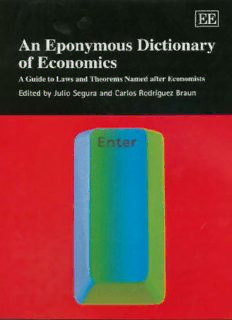
An eponymous dictionary of economics: a guide to laws and theorems named after economists PDF
Preview An eponymous dictionary of economics: a guide to laws and theorems named after economists
An Eponymous Dictionary of Economics An Eponymous Dictionary of Economics A Guide to Laws and Theorems Named after Economists Edited by Julio Segura Professor of Economic Theory, Universidad Complutense, Madrid, Spain, and Carlos Rodríguez Braun Professor of History of Economic Thought, Universidad Complutense, Madrid, Spain Edward Elgar Cheltenham, UK • Northampton, MA, USA © Carlos Rodríguez Braun and Julio Segura 2004 All rights reserved. No part of this publication may be reproduced, stored in a retrieval system or transmitted in any form or by any means, electronic, mechanical or photocopying, recording, or otherwise without the prior permission of the publisher. Published by Edward Elgar Publishing Limited Glensanda House Montpellier Parade Cheltenham Glos GL50 1UA UK Edward Elgar Publishing, Inc. 136 West Street Suite 202 Northampton Massachusetts 01060 USA A catalogue record for this book is available from the British Library ISBN 1 84376 029 0 (cased) Typeset by Cambrian Typesetters, Frimley, Surrey Printed and bound in Great Britain by MPG Books Ltd, Bodmin, Cornwall Contents List of contributors and their entries xiii Preface xxvii Adam Smith problem 1 Adam Smith’s invisible hand 1 Aitken’s theorem 3 Akerlof’s ‘lemons’ 3 Allais paradox 4 Areeda–Turner predation rule 4 Arrow’s impossibility theorem 6 Arrow’s learning by doing 8 Arrow–Debreu general equilibrium model 9 Arrow–Pratt’s measure of risk aversion 10 Atkinson’s index 11 Averch–Johnson effect 12 Babbage’s principle 13 Bagehot’s principle 13 Balassa–Samuelson effect 14 Banach’s contractive mapping principle 14 Baumol’s contestable markets 15 Baumol’s disease 16 Baumol–Tobin transactions demand for cash 17 Bayes’s theorem 18 Bayesian–Nash equilibrium 19 Becher’s principle 20 Becker’s time allocation model 21 Bellman’s principle of optimality and equations 23 Bergson’s social indifference curve 23 Bernoulli’s paradox 24 Berry–Levinsohn–Pakes algorithm 25 Bertrand competition model 25 Beveridge–Nelson decomposition 27 Black–Scholes model 28 Bonferroni bound 29 Boolean algebras 30 Borda’s rule 30 Bowley’s law 31 Box–Cox transformation 31 Box–Jenkins analysis 32 Brouwer fixed point theorem 34 v vi Contents Buchanan’s clubs theory 34 Buridan’s ass 35 Cagan’s hyperinflation model 36 Cairnes–Haberler model 36 Cantillon effect 37 Cantor’s nested intervals theorem 38 Cass–Koopmans criterion 38 Cauchy distribution 39 Cauchy’s sequence 39 Cauchy–Schwarz inequality 40 Chamberlin’s oligopoly model 41 Chipman–Moore–Samuelson compensation criterion 42 Chow’s test 43 Clark problem 43 Clark–Fisher hypothesis 44 Clark–Knight paradigm 44 Coase conjecture 45 Coase theorem 46 Cobb–Douglas function 47 Cochrane–Orcutt procedure 48 Condorcet’s criterion 49 Cournot aggregation condition 50 Cournot’s oligopoly model 51 Cowles Commission 52 Cox’s test 53 Davenant–King law of demand 54 Díaz–Alejandro effect 54 Dickey–Fuller test 55 Director’s law 56 Divisia index 57 Dixit–Stiglitz monopolistic competition model 58 Dorfman–Steiner condition 60 Duesenberry demonstration effect 60 Durbin–Watson statistic 61 Durbin–Wu–Hausman test 62 Edgeworth box 63 Edgeworth expansion 65 Edgeworth oligopoly model 66 Edgeworth taxation paradox 67 Ellsberg paradox 68 Engel aggregation condition 68 Engel curve 69 Engel’s law 71 Contents vii Engle–Granger method 72 Euclidean spaces 72 Euler’s theorem and equations 73 Farrell’s technical efficiency measurement 75 Faustmann–Ohlin theorem 75 Fisher effect 76 Fisher–Shiller expectations hypothesis 77 Fourier transform 77 Friedman’s rule for monetary policy 79 Friedman–Savage hypothesis 80 Fullarton’s principle 81 Fullerton–King’s effective marginal tax rate 82 Gale–Nikaido theorem 83 Gaussian distribution 84 Gauss–Markov theorem 86 Genberg–Zecher criterion 87 Gerschenkron’s growth hypothesis 87 Gibbard–Satterthwaite theorem 88 Gibbs sampling 89 Gibrat’s law 90 Gibson’s paradox 90 Giffen goods 91 Gini’s coefficient 91 Goodhart’s law 92 Gorman’s polar form 92 Gossen’s laws 93 Graham’s demand 94 Graham’s paradox 95 Granger’s causality test 96 Gresham’s law 97 Gresham’s law in politics 98 Haavelmo balanced budget theorem 99 Hamiltonian function and Hamilton–Jacobi equations 100 Hansen–Perlof effect 101 Harberger’s triangle 101 Harris–Todaro model 102 Harrod’s technical progress 103 Harrod–Domar model 104 Harsanyi’s equiprobability model 105 Hausman’s test 105 Hawkins–Simon theorem 106 Hayekian triangle 107 Heckman’s two-step method 108 viii Contents Heckscher–Ohlin theorem 109 Herfindahl–Hirschman index 111 Hermann–Schmoller definition 111 Hessian matrix and determinant 112 Hicks compensation criterion 113 Hicks composite commodities 113 Hicks’s technical progress 113 Hicksian demand 114 Hicksian perfect stability 115 Hicks–Hansen model 116 Hodrick–Prescott decomposition 118 Hotelling’s model of spatial competition 118 Hotelling’s T2statistic 119 Hotelling’s theorem 120 Hume’s fork 121 Hume’s law 121 Itô’s lemma 123 Jarque–Bera test 125 Johansen’s procedure 125 Jones’s magnification effect 126 Juglar cycle 126 Kakutani’s fixed point theorem 128 Kakwani index 128 Kalai–Smorodinsky bargaining solution 129 Kaldor compensation criterion 129 Kaldor paradox 130 Kaldor’s growth laws 131 Kaldor–Meade expenditure tax 131 Kalman filter 132 Kelvin’s dictum 133 Keynes effect 134 Keynes’s demand for money 134 Keynes’s plan 136 Kitchin cycle 137 Kolmogorov’s large numbers law 137 Kolmogorov–Smirnov test 138 Kondratieff long waves 139 Koopman’s efficiency criterion 140 Kuhn–Tucker theorem 140 Kuznets’s curve 141 Kuznets’s swings 142 Laffer’s curve 143 Lagrange multipliers 143 Contents ix Lagrange multiplier test 144 Lancaster’s characteristics 146 Lancaster–Lipsey’s second best 146 Lange–Lerner mechanism 147 Laspeyres index 148 Lauderdale’s paradox 148 Learned Hand formula 149 Lebesgue’s measure and integral 149 LeChatelier principle 150 Ledyard–Clark–Groves mechanism 151 Leontief model 152 Leontief paradox 153 Lerner index 154 Lindahl–Samuelson public goods 155 Ljung–Box statistics 156 Longfield paradox 157 Lorenz’s curve 158 Lucas critique 158 Lyapunov’s central limit theorem 159 Lyapunov stability 159 Mann–Wald’s theorem 161 Markov chain model 161 Markov switching autoregressive model 162 Markowitz portfolio selection model 163 Marshall’s external economies 164 Marshall’s stability 165 Marshall’s symmetallism 166 Marshallian demand 166 Marshall–Lerner condition 167 Maskin mechanism 168 Minkowski’s theorem 169 Modigliani–Miller theorem 170 Montaigne dogma 171 Moore’s law 172 Mundell–Fleming model 172 Musgrave’s three branches of the budget 173 Muth’s rational expectations 175 Myerson revelation principle 176 Nash bargaining solution 178 Nash equilibrium 179 Negishi’s stability without recontracting 181 von Neumann’s growth model 182 von Neumann–Morgenstern expected utility theorem 183 von Neumann–Morgenstern stable set 185
Description: